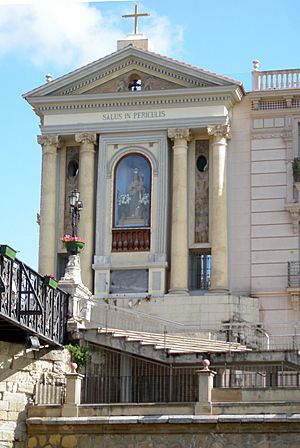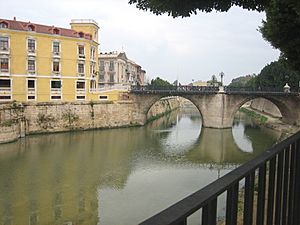Puente de los Peligros facts for kids
The Puente de los Peligros is a famous stone bridge in Murcia, Spain. Its name means "Bridge of the Hazards" in Spanish. It is also called the Puente Viejo, which means "Old Bridge." This bridge was finished in 1742. It crosses the Segura River in the city of Murcia.
It is the oldest bridge in the city. That is why it is called the "Old Bridge." There is also a "New Bridge" (Puente Nuevo) in Murcia, built in 1903.
The name "Puente de los Peligros" comes from a special statue. On the south side of the bridge, there is a small alcove. Inside, you can see a wooden statue of Our Lady of the Hazards. A sculptor named Francisco Sánchez Araciel made this statue.
Contents
History of the Old Bridge
This bridge has a long and interesting history. It replaced an even older bridge.
A Bridge Destroyed
On September 26, 1701, a huge flood hit the city. The flood waters were very strong. They completely destroyed the bridge that was there before. That old bridge was built in the 1500s. It connected the city center to the other side of the river. This was an important link for travelers going to Cartagena.
Starting the New Bridge
It took a while to start building a new bridge. Finally, in 1717, work began. Luis Salas y Sandoval was the Mayor of Murcia at that time. He gave the order to start the project. In the same year, Toribio Martínez de la Vega described the materials needed. A special team was put together to manage the building work.
Getting Ready to Build
In April 1717, workers started moving wood. This wood was for the bridge's construction. It was used to build cofferdams and scaffolding. Cofferdams are temporary walls that keep water out. Scaffolding helps workers build high structures. The wood came from far up the Segura River. It took about six months to bring it all to Murcia.
Delays and New Builders
On September 10, 1718, the first stone of the bridge was laid. But soon, the work had to stop. The King of Spain, Philip V, asked Murcia for money. He needed 14,000 doubloons for his new palace. A doubloon was a type of gold coin.
Toribio Martínez de la Vega led the work for seven years. He built the main central pillar and the ends of the bridge. After some small progress, Jerónimo Gómez de la Haya took over. Later, Jaime Bort became the director of the project. Bort followed Martínez de la Vega's plans. He also made the bridge entrances wider. He even removed part of the old city wall near the bridge.
Finishing the Bridge
The construction stopped again for a while. But it started up again in 1739. This time, the work continued until it was finished in 1742. On September 12, 1742, the wooden statue of Our Lady of the Hazards was placed on the bridge. This statue gave the bridge its famous name. The beautiful neoclassical alcove for the statue was built later. Statues of Saint Michael and Saint Raphael were also added. These were made by Joaquín Laguna.
Widening the Bridge
In 1850, the bridge was made wider. This was done to add two sidewalks for people to walk on. Metal structures were attached to the sides. Some decorative parts of the bridge were removed then. This first widening was not enough. So, in 1867, the bridge was made even wider with more metal. This gave the bridge the look it has today.
A Strong Bridge
The Puente de los Peligros was a great success. It was the first permanent bridge in Murcia. It could handle the river's floods. Even the huge flood of Santa Teresa in 1879 did not destroy it. This bridge has stood strong for centuries.
See also
 In Spanish: Puente de los Peligros para niños
In Spanish: Puente de los Peligros para niños




